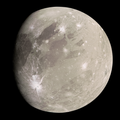 An image of El, partly visible in the upper right, along with another crater named Khensu to the west, taken by the Galileo space probe on November 26, 1997. | |
| Feature type | Multi-ringed, pit crater |
|---|---|
| Coordinates | 1°01′N151°22′W / 1.01°N 151.36°W [1] |
| Diameter | 55 kilometres (34 mi) |
| Eponym | El |
El is a crater on Ganymede. It has a small "pit" in its center. Craters with such a "central pit" are common across Ganymede and are especially intriguing since they may reveal secrets about the structure of the satellite's shallow subsurface. [2]
